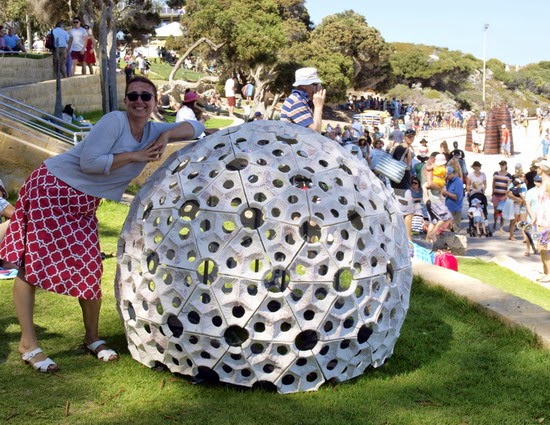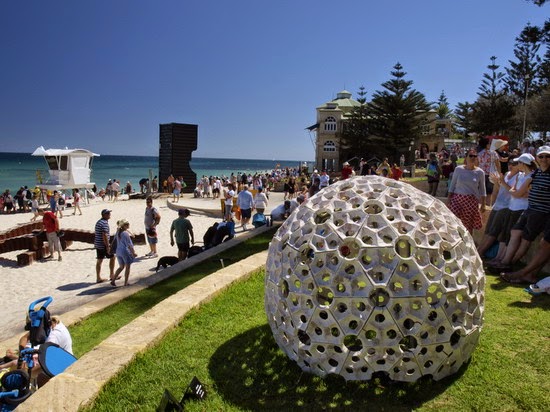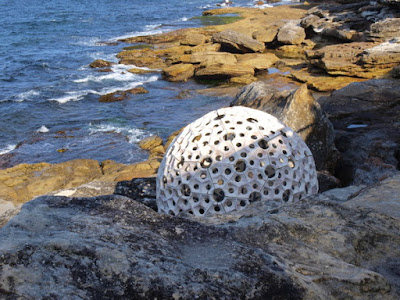Friday, 3 October 2014
New challenge
Here & Now 14 has ended and Shape of Thought has been taken apart to transport back to the studio.
For some time now I have been pondering how to improve the design, and the obvious conclusion is to replace the brackets with the sturdier, welded construction.
I have even done a welding for sculptors workshop in anticipation of the next challenge.
The next sculpture will be based on the geodesic dome again...I feel that I have just started exploring the structure and I still have a long way to go. Well, at least this time the starting point is a bit further down the path, in comparison to the Shape of Thought.
I need to begin by considering the welded frame first, as that will influence the shape of ceramic triangles.
First, let's look at the geodesic sphere again:
What is not immediately obvious is the angle between the 2 triangles, and that angle complicates my construction. It is a bit clearer on those drawings:
If I decided to make a typical geodesic dome framework (which follows the edge of the triangle lines), using the metal flats instead of rods so that I can attach ceramic pieces to them, I would have to weld ( or bend) each flat to have the angle shown on the lower drawing (left).
Bending would be impossible on the lengths I require, and welding impractical.
On the Shape of thought, if you remember, I have used brackets instead. It looked good, but did not provide any structural strength:
This time, the idea is to use steel flats instead of brackets, welded together into some sort of a net, to which I will be able to bolt ceramic pieces in similar fashion to the work on the photo.
Instead of scanning pages and pages of sketches to illustrate the thinking process, I will present you with the 3 finalists:
Let's see what they look like connected together. Black lines represent steel flats:
Which one is the best for my purpose?
Tuesday, 7 October 2014
Options, alternatives and preferences
For aesthetic purposes, I favour "Y" shape for the steel frame. It will be possibly more difficult to construct than "T" shape ( more welding), but it's symmetry makes a good base for the ceramic triangle.
Ah, the triangle.......fun is in the coming up with many options....
and than choosing the right one....
This is approximately what it would look like:
Maybe I should make it slightly larger than the last one.....
Wednesday, 19 November 2014
Mould making
I have been absent for a while, recharging my batteries in New Zealand. It was my first visit and I think I'm in love...everything was so green and beautiful. My inspiration folder is full of images of rocks, plants and textures.
But now that I am back in the studio, it's time to begin prototyping new triangular modules.
I have done the maths, drawn the triangles the size I want to make them and cut them out of the stiff paper. I have found out that the good quality watercolour paper works well for this purpose as it can withstand getting wet on clay multiple times.
My husband made interlocking wooden frames, already cut on the 7 degrees angle so my clay triangle will be larger on the top and smaller on the bottom:
At first I thought that I will hand-build each triangle within the frame
but when I realized that making the first one took close to 2 hours I decided to make a plaster mould.
I also decided to keep wooden frame as part of the mould as it takes care nicely of the 7 degrees angle which would create undercut in a one piece plaster mould.
This is the "lazy mould maker's" way of making the framework for pouring plaster:
And here it is, plaster poured. It will be ready for removal of framework in an hour or so...
Sunday, 23 November 2014
Naming
Just as I would not name a baby before it is born, I usually don't name my work before it is finished. The reasons are simple ( in the case of my work, not necessarily applicable to babies): during the making process I like to leave the options open for the piece to evolve and change. Sometimes the piece doesn't change much, but my understanding of it does as I research, think about it and make it...and therefore the name reflects that new perspective and understanding.
This sculpture is different.
It started its virtual existence as a proposal to the Sculpture by the Sea 2015 at Cottesloe, Perth. The proposal had to be very detailed and include concept drawings, sizes, colours, weight and the title, among the other things.
To my absolute delight and amazement the proposal has been accepted, subject to safety requirements.
The letter I have received stating the deadlines has given me a gentle push in the right direction.... And so the making has begun.
Oh, you would like to know the name? I'm not sure I should tell you, after all, it has not been made yet ( yes, I almost said "born")
well, all right...
It is called:
Intuitive Sense of Connection
As usual, you will be able to follow its progress here, and I hope that you get to see it at Cottesloe next year.





















































































No comments:
Post a Comment